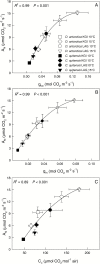Photosynthetic limitations in two Antarctic vascular plants: importance of leaf anatomical traits and Rubisco kinetic parameters
- PMID: 28830100
- PMCID: PMC5854023
- DOI: 10.1093/jxb/erx148
Photosynthetic limitations in two Antarctic vascular plants: importance of leaf anatomical traits and Rubisco kinetic parameters
Abstract
Particular physiological traits allow the vascular plants Deschampsia antarctica Desv. and Colobanthus quitensis (Kunth) Bartl. to inhabit Antarctica. The photosynthetic performance of these species was evaluated in situ, focusing on diffusive and biochemical constraints to CO2 assimilation. Leaf gas exchange, Chl a fluorescence, leaf ultrastructure, and Rubisco catalytic properties were examined in plants growing on King George and Lagotellerie islands. In spite of the species- and population-specific effects of the measurement temperature on the main photosynthetic parameters, CO2 assimilation was highly limited by CO2 diffusion. In particular, the mesophyll conductance (gm)-estimated from both gas exchange and leaf chlorophyll fluorescence and modeled from leaf anatomy-was remarkably low, restricting CO2 diffusion and imposing the strongest constraint to CO2 acquisition. Rubisco presented a high specificity for CO2 as determined in vitro, suggesting a tight co-ordination between CO2 diffusion and leaf biochemistry that may be critical ultimately to optimize carbon balance in these species. Interestingly, both anatomical and biochemical traits resembled those described in plants from arid environments, providing a new insight into plant functional acclimation to extreme conditions. Understanding what actually limits photosynthesis in these species is important to anticipate their responses to the ongoing and predicted rapid warming in the Antarctic Peninsula.
Keywords: Antarctic plants; Rubisco; leaf traits; mesophyll conductance; photosynthesis; temperature.
© The Author 2017. Published by Oxford University Press on behalf of the Society for Experimental Biology.
Figures







Similar articles
-
In situ warming in the Antarctic: effects on growth and photosynthesis in Antarctic vascular plants.New Phytol. 2018 Jun;218(4):1406-1418. doi: 10.1111/nph.15124. Epub 2018 Apr 23. New Phytol. 2018. PMID: 29682746
-
Contrasting thermal acclimation of leaf dark respiration and photosynthesis of Antarctic vascular plant species exposed to nocturnal warming.Physiol Plant. 2019 Oct;167(2):205-216. doi: 10.1111/ppl.12881. Epub 2019 Feb 8. Physiol Plant. 2019. PMID: 30467866
-
Leaf hydraulic properties of Antarctic plants: effects of growth temperature and its coordination with photosynthesis.J Exp Bot. 2024 Mar 27;75(7):2013-2026. doi: 10.1093/jxb/erad474. J Exp Bot. 2024. PMID: 38173309
-
Mesophyll conductance to CO2 and Rubisco as targets for improving intrinsic water use efficiency in C3 plants.Plant Cell Environ. 2016 May;39(5):965-82. doi: 10.1111/pce.12622. Epub 2015 Dec 11. Plant Cell Environ. 2016. PMID: 26297108 Review.
-
How do vascular plants perform photosynthesis in extreme environments? An integrative ecophysiological and biochemical story.Plant J. 2020 Feb;101(4):979-1000. doi: 10.1111/tpj.14694. Epub 2020 Feb 21. Plant J. 2020. PMID: 31953876 Review.
Cited by
-
Identification of Rice Genes Associated With Enhanced Cold Tolerance by Comparative Transcriptome Analysis With Two Transgenic Rice Plants Overexpressing DaCBF4 or DaCBF7, Isolated From Antarctic Flowering Plant Deschampsia antarctica.Front Plant Sci. 2018 May 3;9:601. doi: 10.3389/fpls.2018.00601. eCollection 2018. Front Plant Sci. 2018. PMID: 29774046 Free PMC article.
-
Cell wall thickness constrains photosynthesis of coexisting species in a subtropical plantation by reducing mesophyll conductance and maximum carboxylation rate.Tree Physiol. 2025 Aug 5;45(8):tpaf078. doi: 10.1093/treephys/tpaf078. Tree Physiol. 2025. PMID: 40626968 Free PMC article.
-
A Changing Light Environment Induces Significant Lateral CO2 Diffusion within Maize Leaves.Int J Mol Sci. 2022 Nov 22;23(23):14530. doi: 10.3390/ijms232314530. Int J Mol Sci. 2022. PMID: 36498855 Free PMC article.
-
Physiological Responses of Crotalaria spp. to the Presence of High Aluminum Availability in the Soil.Plants (Basel). 2024 Aug 17;13(16):2292. doi: 10.3390/plants13162292. Plants (Basel). 2024. PMID: 39204729 Free PMC article.
-
Estimation of light utilisation and antioxidative protection in an alpine plant species (Soldanella alpina L.) during the leaf life cycle at high elevation.Physiol Plant. 2025 Jan-Feb;177(1):e70045. doi: 10.1111/ppl.70045. Physiol Plant. 2025. PMID: 39821193 Free PMC article.
References
-
- Alberdi M, Bravo LA, Gutiérrez A, Gidekel M, Corcuera LJ. 2002. Ecophysiology of Antarctic vascular plants. Physiologia Plantarum 115, 479–486. - PubMed
-
- Badger MR, Collatz GJ. 1977. Studies on the kinetic mechanism of ribulose-1, 5-bisphosphate carboxylase and oxygenase reactions, with particular reference to the effect of temperature on kinetic parameters. Carnegie Institute of Washington Yearbook 76, 355–361.
-
- Brooks A, Farquhar GD. 1985. Effect of temperature on the CO2/O2 specificity of ribulose-1, 5-bisphosphate carboxylase/oxygenase and the rate of respiration in the light. Planta 165, 397–406. - PubMed
-
- Carriquí M, Cabrera HM, Conesa MÀ, et al. 2015. Diffusional limitations explain the lower photosynthetic capacity of ferns as compared with angiosperms in a common garden study. Plant, Cell and Environment 38, 448–460. - PubMed
-
- Cavieres LA, Sáez P, Sanhueza C, Sierra-Almeida A, Rabert C, Corcuera LJ, Bravo LA. 2016. Ecophysiological traits of Antarctic vascular plants: their importance in the responses to climate change. Plant Ecology 217, 343–358.
Publication types
MeSH terms
Substances
LinkOut - more resources
Full Text Sources
Other Literature Sources

